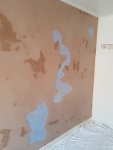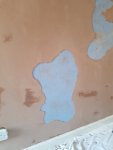This is shortened version of events of my dilemma.
Not been doing domestics for long so any advice would be appreciated.
Customer's bedroom had 1 outside wall that been left floated & then painted by previous owners.
He had a "handyman" from FB skim this wall,he let it dry,mist coated it with added pva in the mix & then several areas of plaster blew!
I quoted to remove all blown areas,pva& skim.
Did this,which left a small area of handyman's skim so pva'd all wall twice,skimmed when tacky and then on one trowelling up noticed it bubbling up in small areas which then became what's in photos.
Completely confused as to why this happened as this area of wall didn't react adversely to the pva before skimming.
I said I will get back to customer with possible solution he said he'll just hack all back to floated wall & paint that if there isn't an answer.
Anybody had this happen before & what's the solution?
Not been doing domestics for long so any advice would be appreciated.
Customer's bedroom had 1 outside wall that been left floated & then painted by previous owners.
He had a "handyman" from FB skim this wall,he let it dry,mist coated it with added pva in the mix & then several areas of plaster blew!
I quoted to remove all blown areas,pva& skim.
Did this,which left a small area of handyman's skim so pva'd all wall twice,skimmed when tacky and then on one trowelling up noticed it bubbling up in small areas which then became what's in photos.
Completely confused as to why this happened as this area of wall didn't react adversely to the pva before skimming.
I said I will get back to customer with possible solution he said he'll just hack all back to floated wall & paint that if there isn't an answer.
Anybody had this happen before & what's the solution?


